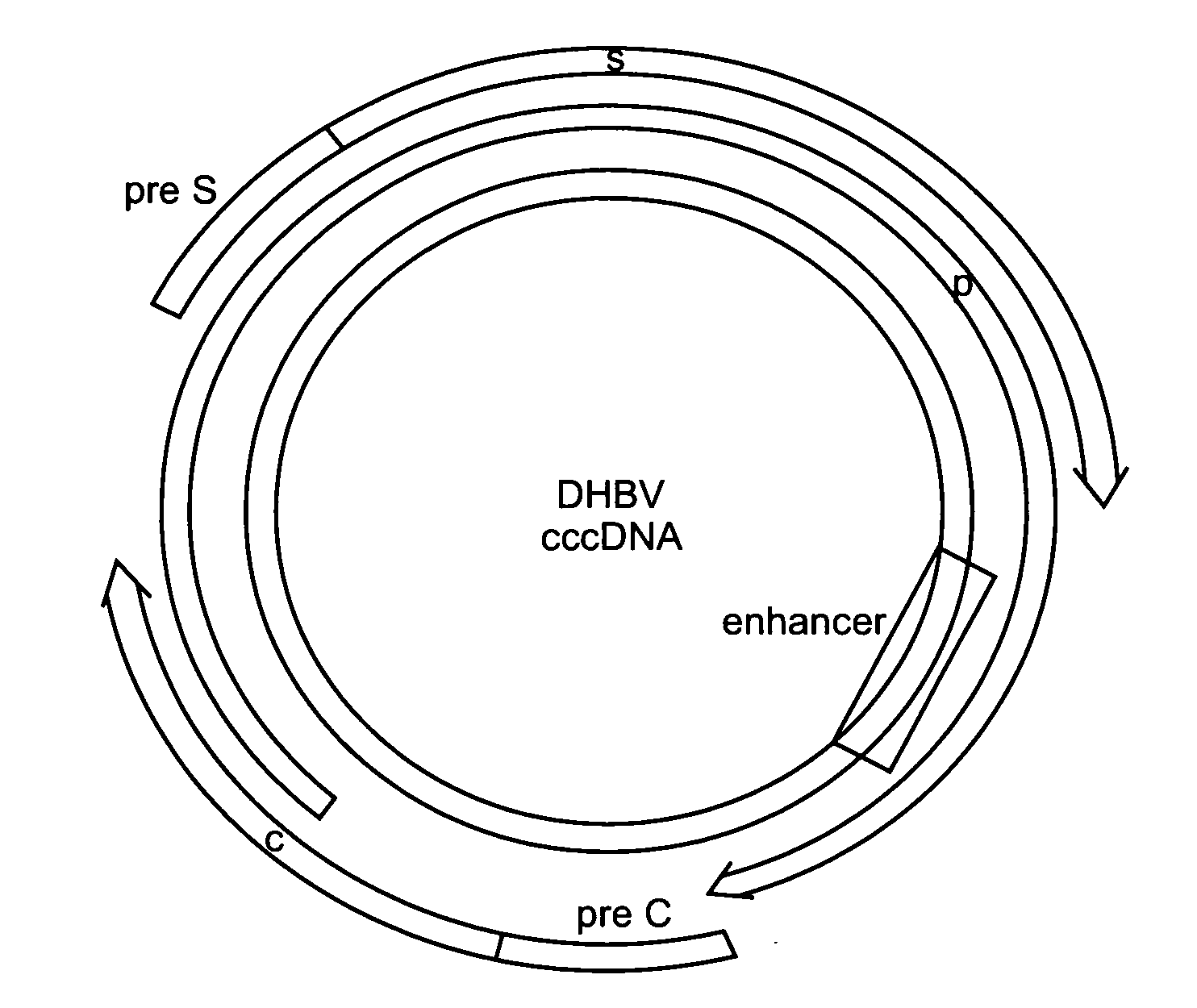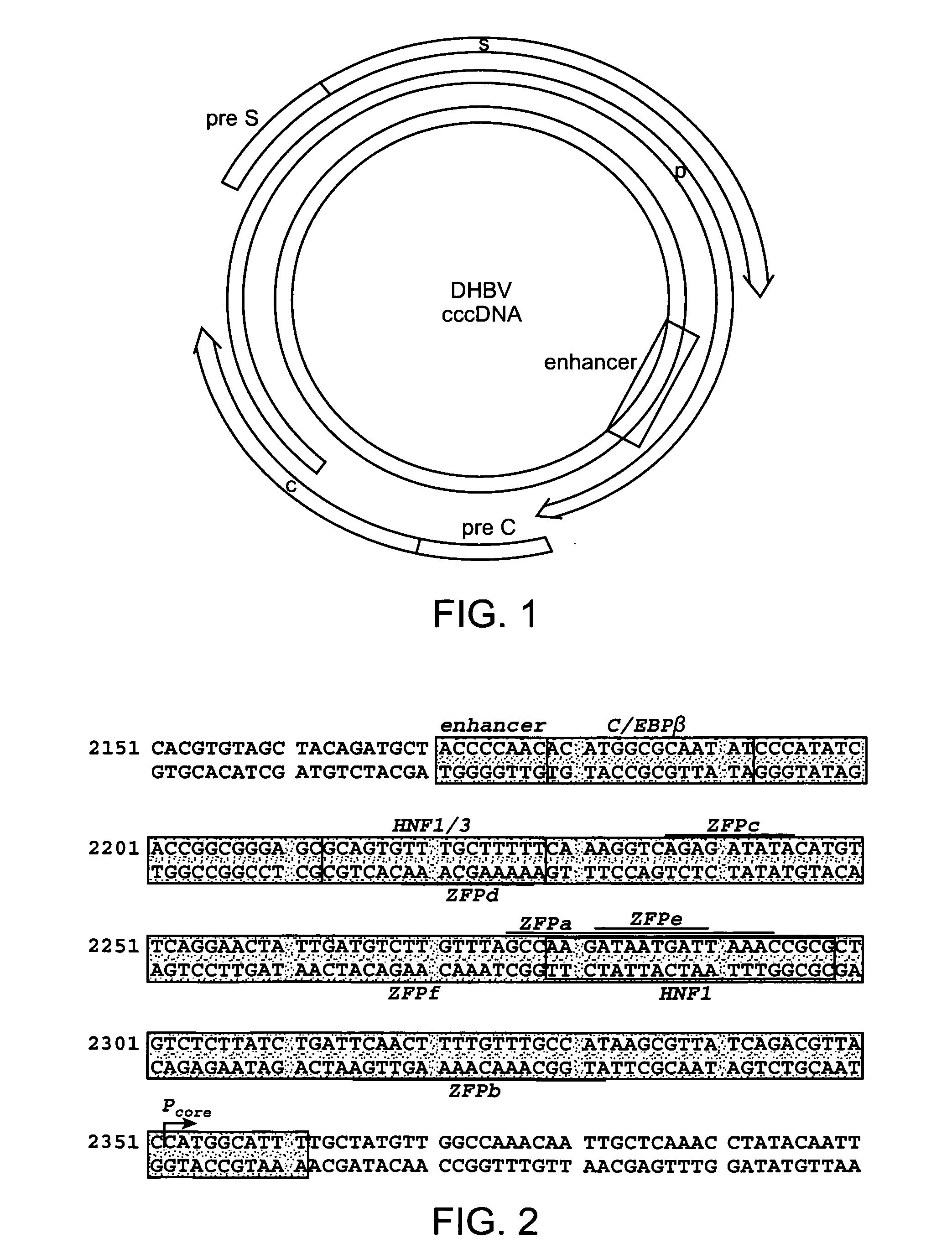Hepatitis b virus-binding polypeptides and methods of use thereof
a technology of hepatitis b and polypeptides, applied in the field of hepatitis b virus-binding polypeptides, can solve the problems of resurgence of viral production, increasing resistance to nucleoside analogs, and significant global health burden
- Summary
- Abstract
- Description
- Claims
- Application Information
AI Technical Summary
Benefits of technology
Problems solved by technology
Method used
Image
Examples
example 1
Designing ZFPs to Target DHBV cccDNA and HBV cccDNA
Materials and Methods
[0415]The Zinc Finger Tools site, which can be located on the world wide web at the following address (www.scripps.edu / mb / barbas / zfdesign / zfdesignhome.php) (Mandell and Barbas, Nucleic Acids Res. 2006 Jul. 1; 34 (Web Server issue):W516-23), provides several tools for selecting zinc finger protein (ZFP) target sites and for designing the proteins that will target them. The first tool, “Search DNA Sequence for Contiguous or Separated Target Sites”, was used to scan a given DNA sequence for consecutive DNA triplets that can be targeted with the zinc finger domains published (Dreier B et al, 2000 J Mol Biol. 303(4): 489-502; Dreier B et al, 2001 J Biol Chem. 276(31): 29466-78; Dreier et al, 2005 J Biol Chem. 280(42): 35588-97; Segal D J et al, 1999 J Biol Chem. 279(15): 14509-14519). Specifically, the entire DHBV genome (Canada isolate, AF047045) was scanned and the entire HBV genome (subtype ayw U95551) to find DNA...
example 2
Assessment of Dissociation Constants and Binding Affinities for ZFPs a-f Using Electrophoretic Mobility Shift Assays (EMSA)
[0442]ZFPs a-f were expressed and purified in Escherichia coli as fusions to maltose binding protein (MBP). ZFP-MBP fusion proteins were isolated on amylose columns and found to be approximately 95% pure by SDS-PAGE and Coomassie blue stain. FIG. 3 shows the results of a Coomassie blue stain of purified ZFPa. BL21(DE3) cells were transformed with the pMAL-ZFPa vector and induced using IPTG for 2 hours. Cells were lysed and ZFPa was isolated on an amylose resin column, then eluted using 10 mM maltose. Lane 1: Whole cell lysates. Lane 2: Whole cell lysates induced by IPTG. Lane 3: Soluble fraction. Lane 4. Insoluble fraction. Lane 5: Amylose column eluate.
[0443]Electrophoretic mobility shift assays (EMSA) were performed to assess the binding capacities of each ZFP. Three of the six ZFPs, caused a shift in the mobility of their cognate double-stranded (ds) DNA olig...
example 3
Assessment of Dissociation Constants for ZFPs a-f Using SPR
[0446]Surface plasmon resonance (SPR) is a more sensitive technique than EMSA and was able to detect binding by all six ZFPs to their target oligonucleotides. FIG. 22 shows the general kinetic equation, which describes the kinetic relationship between a ZFP (A) and its target DNA (B). The association constant (Ka) is the ratio of the Kon over the Koff rates, while the dissociation constant (Kd) is the inverse of the Ka.
[0447]Kinetic graphs such as seen in FIGS. 7, 8 and 10A-10D were produced using BIA-evaluation software. FIGS. 7 and 8 show BIAcore kinetic analysis of ZFPa and ZFPb respectively. Each line represents duplicate analysis of different concentrations of ZFP, ranging from 4 nM to 128 nM (ZFPa) or 1.7 nM to 220 nM (ZFPb). Three blanks in duplicate were also performed. Response difference is measured in resonance units (RU) and represents the binding of the ZFP to the anchored oligonucleotides. FIGS. 10A, 10B, 10C a...
PUM
| Property | Measurement | Unit |
|---|---|---|
| particle size | aaaaa | aaaaa |
| time | aaaaa | aaaaa |
| time | aaaaa | aaaaa |
Abstract
Description
Claims
Application Information
 Login to View More
Login to View More - R&D
- Intellectual Property
- Life Sciences
- Materials
- Tech Scout
- Unparalleled Data Quality
- Higher Quality Content
- 60% Fewer Hallucinations
Browse by: Latest US Patents, China's latest patents, Technical Efficacy Thesaurus, Application Domain, Technology Topic, Popular Technical Reports.
© 2025 PatSnap. All rights reserved.Legal|Privacy policy|Modern Slavery Act Transparency Statement|Sitemap|About US| Contact US: help@patsnap.com



